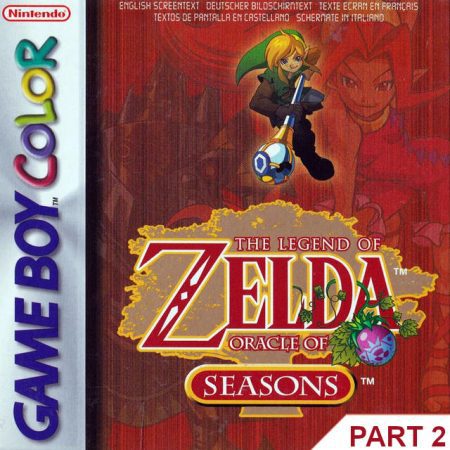In Part 1 of The Legend of Zelda: Oracle of Seasons article, we looked at how Flagship’s developers regulated difficulty during periods of exploration by controlling how many screens were unlocked at any one time. Let’s continue our deep dive into over-world map design, but this time around, we will focus on a second difficulty regulation strategy the developer has at their disposal – multiple routes!
We actually touched on this in the previous article a little too. However, it will be beneficial to take a look at it in more detail using another great example from The Oracle of Seasons. Let’s get into it.
After Link’s first voyage to the subterranean land of Subrosia, he is given the Rod of Seasons. The player is then given the hint to head eastward when they return to Holodrum, towards the Woods of Winter where they will find the next essence (eight of which must be collected to save Holodrum). Upon stepping out of the portal, the wandering prophet, Sokra makes mention of the rod of seasons and strongly suggests the player use it a top a large tree stump nearby. Doing so will shift the season from Autumn to Winter, thereby making some changes to the geography in the area. Specifically, the rod of seasons (a key) has turned an impassable body of water (a lock) into solid ice, allowing the way forward into the Woods of Winter.
It is here the developers begin the process of corridor expansion again as discussed in the last article (a new area to explore is unlocked). 13 new screens are now available and, while the player thinks they are just exploring the woods, they are actually being expertly funneled towards a little girl named Holly and a house located in the far north-east of the woods – right where the next progression item is located.
Rather than one pathway that leads to the shovel (the item required to access the next dungeon), the developers have designed the map to function more like a loop whereby the player is given a choice between a northern or southern route. In this way, the game offers a sense of adventure and the impression that the player is off the beaten path, scratching that itch felt by those veteran Zelda fans that wish for the freedom of choice experienced in the original Legend of Zelda. At the same time, a beginner player will get the same sense of adventure, but will end up at Holly’s house no matter what choice they make as well. In other words:
Two or more routes that converge towards the same progression item will create a strong sense of exploration while still funneling a player towards game progression.
Having read a sign outside Holly’s House that reads ‘Santa is welcome’, turned the season to winter to gain access to the roof and jumped down the chimney to bypass the locked front door (seriously, that sign is one of the best clues in the game!), Link will have received a shovel for his efforts. With this new item collected, and the ability to eradicate snow and dirt mounds that block the way, 3 additional screens have been unlocked.
This is a similar situation to when Link found the Hero’s Sword and Gnarled Key in the first hour of gameplay and the way towards the first dungeon was unlocked – that map expansion was also only 3 additional screens. The developers are now shifting the game-play away from exploration, contracting that corridor and pushing the player towards a period of action inside the Snake Remains – the second dungeon.
It is now that the Woods of Winter’s excellent map design shows it’s true colors!
Firstly, because the map is a loop, and the player is typically driven to explore any area not yet traveled, they will continue to circle around the woods, no matter what direction they came from. So no matter what, the player will end up crossing paths with some mounds of snow just asking to be shoveled. Which will in turn lead them straight to the Snakes Remains dungeon.
Notice that the player must walk by the mounds of snow if they decide to leave the Woods of Winter without first locating the second dungeon. But, if the player doesn’t happen to make the connection between mounds of snow and shoveling them with their new found progression item, the developers have added an additional clue. Not with a sign or an NPC though, but with a simple addition to the geography of the landscape and an elaborate dungeon entrance.
The player can enter the screen containing the second dungeon’s entrance before they can use the shovel by entering a dead end from the northern route during winter, or the western route during autumn. As mentioned before, it doesn’t matter what direction the player took when they first set foot in the Woods of Winter, they will still be passing through the northern route whether they are on their way in or out. And because the Snakes Remains dungeon entrance is quite an elaborate design, it tends to bake itself into the players mind, planting a desire to locate the door from the east. It is a way to lay breadcrumbs for the player to follow. To put it simply:
Allowing the player to see a point of interest on a map but not initially access that same point of interest reduces the risk of players passing it by completely and getting frustratingly stuck.
All in all, this section of Oracle of Seasons is wonderfully designed. It offers a sense of adventure all while making sure beginner players aren’t left scratching their heads by utilizing all of the strategies discussed in these two articles to great effect!
To finish off, I would like to share with you a graph I have constructed. It measures all additional screens unlocked in the over-world map when the player finds a new progression item throughout the entire game.
Woah! That’s a lot of information to process. But if we break it down piece by piece, we can learn much about how the developers shifted their game-flow design as the game went on.
First of all, we can see that a similar game-flow design as the first and second dungeons has been employed for the third, fourth and fifth dungeons (I have labelled them LVL’s in line with the game itself). That is, a period of exploration has occurred only for the player to unlock entry to the next dungeon without any further expansion to the over-world map (all marked ‘0’ in yellow). So, for over half of the game, the developers have decided that the contraction of exploratory corridors is the best way to go – to make sure beginners aren’t overwhelmed as most of the over-world map is unlocked.
On that note, we can see that most of the long horizontal bars in the graph are in the top half of the graph and that most of the progression items that unlock 0 screens are in the latter half of the game. That would make sense, as the amount of screens unlocked for every progression item would have to diminish as the game went on – there are only so many over-world screens after all. But this also reveals a shift in the kind of gameplay the developers are offering the player.
When there are no new screens to explore as a result of finding a particular progression item (for example, the magnetic gloves), the player must use their memory to find the lock to that specific key – whether it be optional or on the critical path. This game of memory is much more similar to the gameplay of the original Legend of Zelda as the developers are testing the player’s comprehension of the now very large over-world map. This brings up a very important design strategy for exploration based games:
By placing screens/areas that can be accessed early-on, but within are elements still locked behind a progression item, the developer can introduce information recall and map comprehension into the game.
From the point of view of the player, at some point in the past, the player gained access to a screen. Within this screen was a lock associated with the new progression item, which they did not yet have. It’s now up to the player to remember where it is and return to make further progress. A prime example is the dead end northern route that shows the entrance of the second dungeon in the Woods of Winter (shown in the images above). Or the large pile of snow that needs to be shoveled one screen below that in order to gain access to said dungeon. So this game of memory is also happening on a smaller scale during periods of exploration throughout the game too.
Finally, there is another interesting shift in game-flow design happening with the last three dungeons in tLoZ: Oracle of Seasons. Notice that the exploratory corridor doesn’t contract when access to these dungeons are unlocked, they instead expand! Well, sort of.
In the case of the last three dungeons, it is true that new screens have been unlocked to explore, but these areas are more like elongated narrow corridors filled with puzzle and action elements that lead to the dungeon entrance rather than free roaming open areas.
For example, when the player retrieves the four jewels, they unlock access to the sixth dungeon (they must recall the location of the Tarm Ruins gate). A whopping 20 screens are unlocked, allowing the player to travel through the Lost Woods and Tarm Ruins.
The unlocked screens here are not a free roaming area however, they are a single pathway that has the player fighting monsters and solving small puzzles en route to the dungeon. Which means this path is also a dead-end! But It’s important to note that, at this stage, the player has unlocked the ‘Gale Seeds’, the game’s fast-travel item. Without a way to fast-travel, these one way corridors would mean the player is forced to backtrack through content they have already experienced for no good reason – a cardinal sin of over-world map design! There is nothing wrong with inserting one-way sections into an over-world map. That being said:
Seriously consider warp points or introduce a fast-travel ability before the player accesses one-way paths. This will reduce/eliminate pointless back-tracking and therefore reduce player disengagement.
So, there you have it! I have attempted to be as exhaustive as two articles can allow when describing the over-world map design of The Legend of Zelda: Oracle of Seasons. These kinds of games are quite frankly staggering in their complexity and the closer you look, the more staggering it all becomes. Designing over-world maps effectively is no easy task. It takes dedication, careful planning and a huge amount of time and effort but, by breaking the over-world design down into smaller and smaller moments, a clear direction behind the design becomes more apparent and the job is made more manageable. I hope these articles have allowed you to better appreciate and understand the incredible work Flagship achieved back in 2001 but most of all, I hope the design strategies discussed here will assist in building your own over-world maps – if you’re ever ambitious enough!

Independent Games Designer, Artist, Film Enthusiast and Full-time Dad (he/him). Check out my games here!





